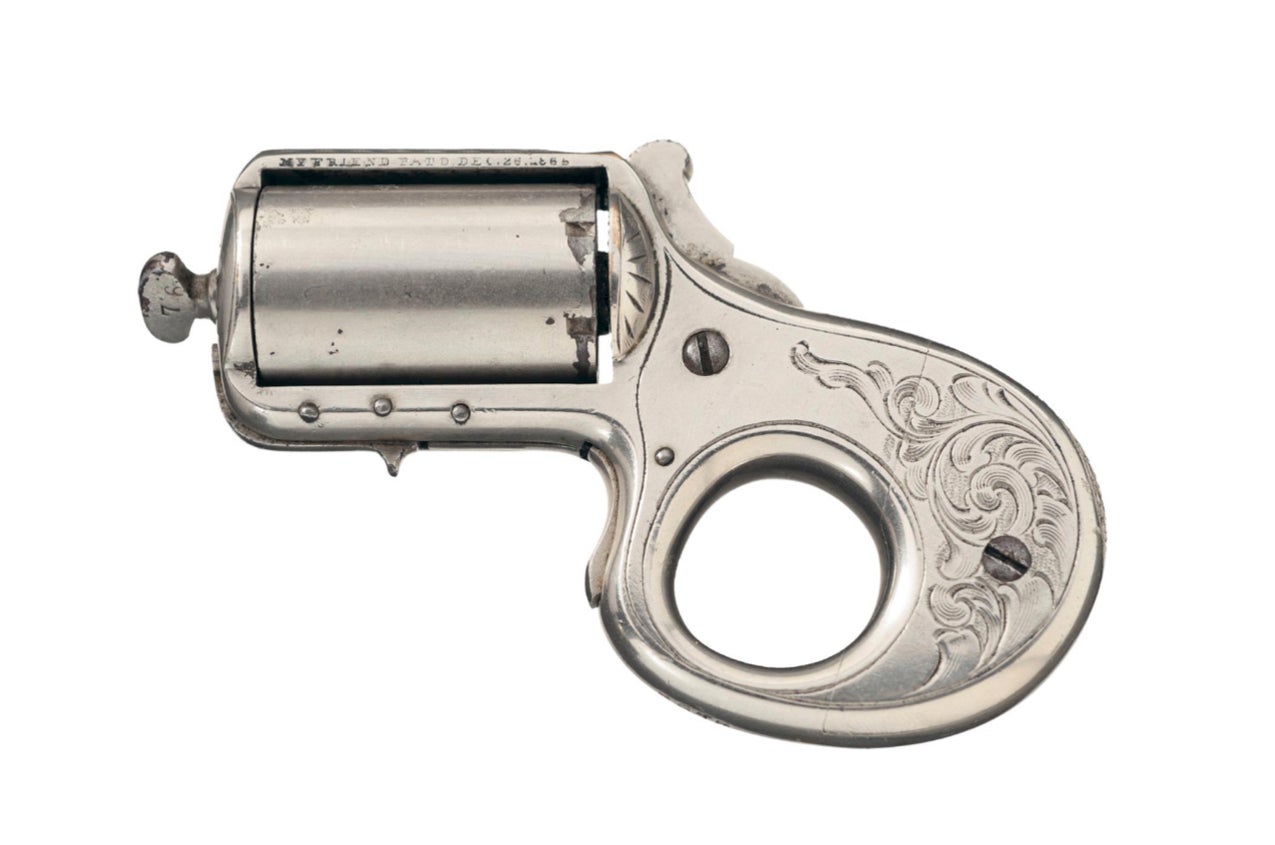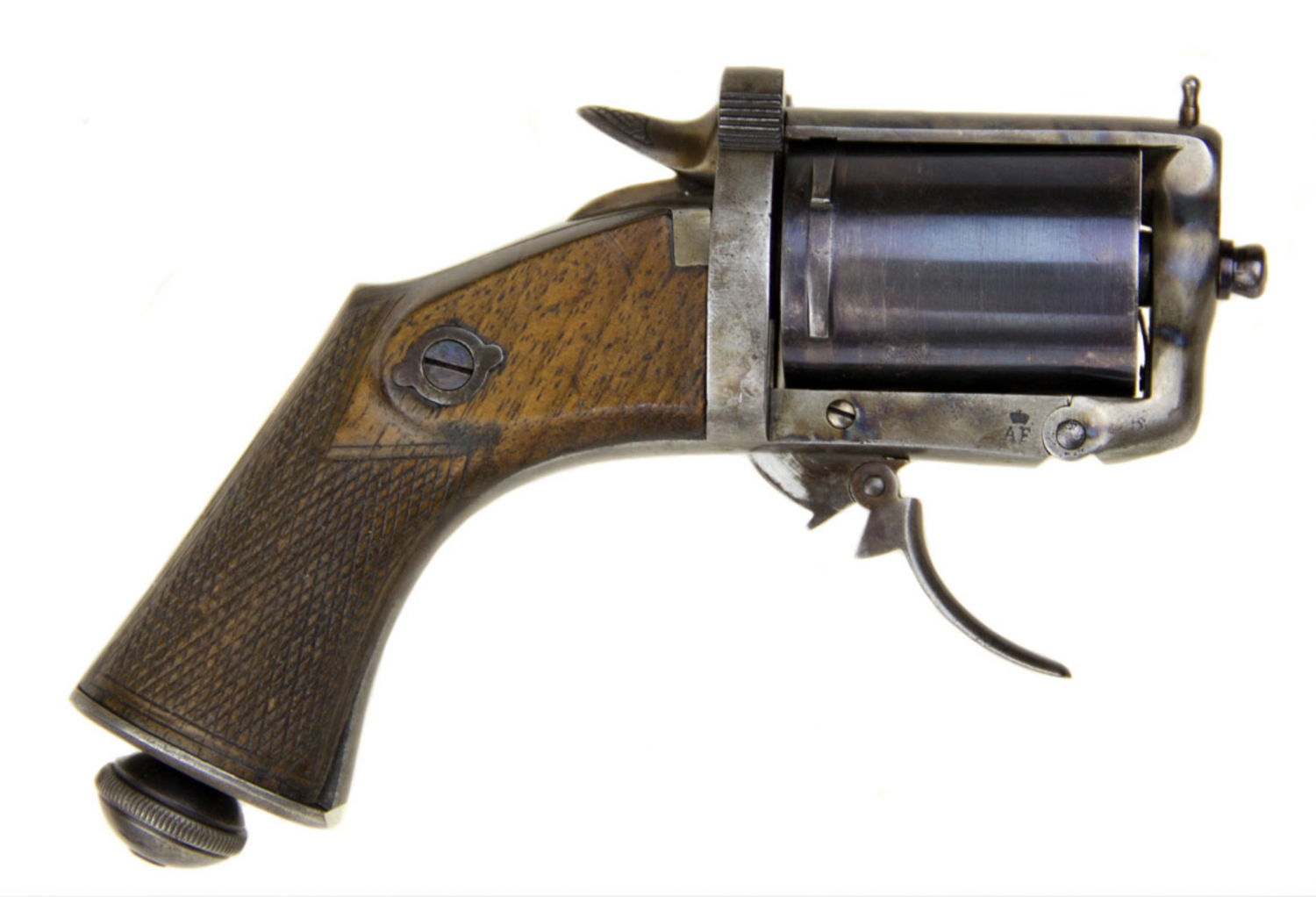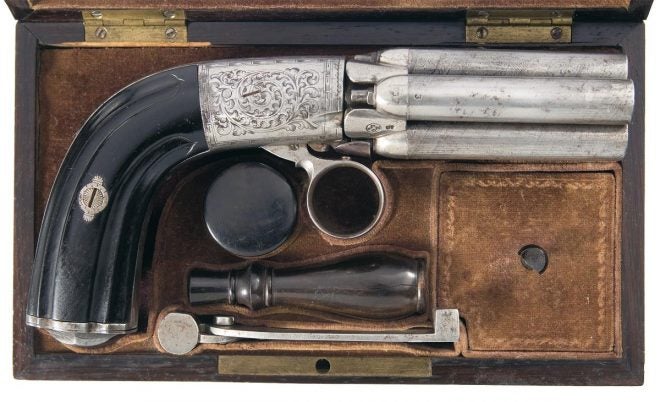From the late 18th to the mid 19th century, revolvers were expensive, uncommon, and had safety issues such as the chain-fire phenomenon, which would destroy the firearm (if you were lucky). Firearms designers and manufacturers recognized the need for multiple shots, and somewhat of a solution to this problem came about in the form of the “Pepperbox”, essentially multiple loaded barrels that could be rotated into the firing position either by manual or mechanical means.
The first examples of pepperbox-type firearms were seen in the 16th century and were matchlocks. One would rotate a barrel and its touch-hole in line with the match mechanism, and set off each pre-loaded barrel, as seen below on this example from Japan’s Edo period.

Japanese Matchlock Pepperbox. Image Credit: Rock Island Auctions
Pepperboxes are not “proto-revolvers”, but more like evolutionary wheelgun offshoots that capitalized on a market void for repeating arms when revolvers were in their early days of development, and even had advantages over the revolver for a little while. Both pepperboxes and revolvers are repeating arms whose chambers rotate around a central axis pin, but while revolvers have a multi-chambered cylinder that must line up with a single barrel (for the most part), the pepperbox simply has multiple barrels.
Nocks and Turnovers
The first commonly produced flintlock pepperbox circa 1790 was by Henry Nock, of Nock Volley Gun fame. Perhaps Nock recognized that 7 barrels going off all at once was a handful. Thereafter, he designed a very elegant flintlock self-priming 6 barreled pepperbox carbine with barrels that rotated around a central axis pin.

Nock Revolving Carbine. Image Credit: Rock Island Auctions
Not all pepperboxes had six barrels. Some of the earliest percussion guns, like “Pinches Turn-Over Pistol” of 1830, had simply two barrels. One would fire the topmost barrel, then place the hammer at half-cock and rotate the bottom barrel to the top position and vice versa. A hook-shaped protrusion would keep the percussion caps in place on the barrel that was not in firing position.
In 1835, a double-hammered, four-barreled version of the “turnover” type was made by Blanch of London. This mechanically advanced percussion pistol had sliding safeties that held the hammers at half-cock, a spring retention system for locking the top and bottom side by side barrels in place, and threaded nipples to keep the percussion caps in place. Lang also made an example of this type in 1840.

Lang’s Turnover Pistol. Image Credit: Carter’s Auctions
Mechanical Marvels
By 1837, Belgian and American patents gave birth to the first repeating arms to operate purely on the function of pulling the trigger. In Belgium, the Mariette-type percussion pepperbox pistol of 1839 had six barrels. Pulling the ring-type trigger would rotate a barrel into the six o’clock firing position (these designers understood low bore axis!) and pull back and release the internal hammer, firing the pistol. After firing all six barrels, or in the event of a bad cap, one could easily rotate and recap the barrels by slight pressure on the trigger. Though six-barreled Mariettes were compact, they also took it to the extreme with a monstrously unwieldily 24-barrel model with 15 exterior barrels superposed around 9 central barrels.

Mariette Pepperbox. Image Credit: Rock Island Auctions
In America, Ethan Allen debuted the “Allen and Thurber” Pepperbox of 1837. The Allen Patent hammer was on the top of the pistol and would fire the barrel at the twelve o’clock position. The hammer functioned by pulling the traditional blade-style trigger, lifting the rear-hinged “Allen Patent” hammer. The trigger would also engage a pawl that would rotate the barrel cluster around the axis pin at the same time. At a certain height, the lifter hook would disengage and fire the pistol. Percussion caps were held in place via a shield that covered all but the topmost cap.

Allen & Thurber Pepperbox
Fistful of Fury
The advent of the pinfire cartridge took pepperbox pistols to the height of their popularity. The French firm of Lefaucheux debuted their “coup de poing” or “fist pistol” in 1850. Looking like an open-frame revolver without a barrel due to the bottom frame extending all the way out to the front of the axis pin, the wildest of such designs was the Dolne-Bar “Apache” pistol, which integrated brass knuckles and a wavy, kris-like bayonet.

Lefaucheux Pinfire Pepperbox. Image Credit: Hermann Historica

Apache fully folded. Image credit: Rock Island Auctions

Apache Pepperbox. Image Credit: Rock Island Auctions
Another closed-front pepperbox with pugilistic backup potential was the “My Friend”, designed in the 1870s by an Irish immigrant to New York, James Reid. A single-action rimfire, this pepperbox was chambered in .22 Short and had a grip/trigger housing that could be used as a knuckle duster if you ran out of rounds. It also features a fully enclosed frame, with a hole drilled out for the firing cylinder.

James Reid “My Friend”. Image Credit: Rock Island Auctions

James Reid “My Friend”. Image Credit: Guns International
Perhaps the finest of 19th-century pepperboxes were the centerfire examples made by Devisme. These pepperboxes were made to a very high standard, and were top-break, centerfire cartridge firearms to boot.

Devisme Centrefire break-open pepperbox. Image Credit: Rusty Old Arms
Back in the Box
Pepperbox pistols had some advantages over early revolvers. Open frame percussion pepperboxes were much safer in a chain fire situation, as there was nothing close to the shooter for a chain-fired ball to impact. They also were functional and reliable double-action firearms before revolvers mastered cocking and firing off the pull of a single trigger. However, their shortcoming of being heavier (multiple long barrels instead of a short cylinder and one long barrel) less balanced and less accurate than the revolver eventually caused them to fall by the wayside.
So what was the most successful pepperbox? In my opinion, it’s not any of the pistols, but the mechanical machinegun made by Richard Gatling, essentially a giant pepperbox whose design descendants sling copper, lead and depleted uranium at incredible rates of fire to this day.
 Your Privacy Choices
Your Privacy Choices
